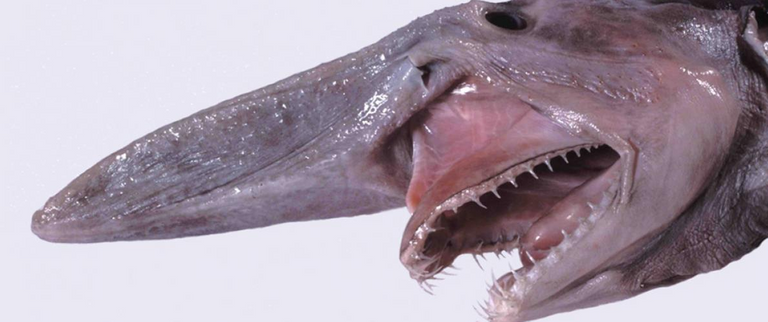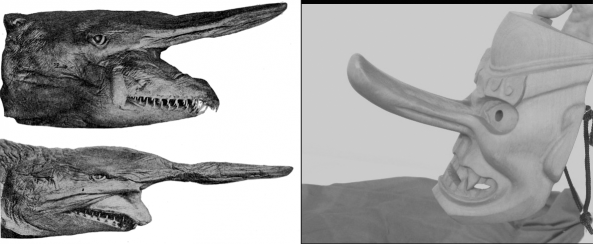
The goblin shark got its name from an interpretation of the Japanese word for this species: tenguzame. Tengu is a reference to a Japanese folk creature that is part bird and part human, and zame translates to shark. The name is likely inspired by the most distinctive feature of the goblin shark – it’s weird, protruding, flat nose which looks like a beak or a traditional tengu mask
This species is found in very deep water and is rarely encountered, so scientists don’t know much about their biology or habits. However, we do know that their weird schnoz is covered in pores leading to a sensory system designed to pick up on electrical signals from prey. It is hypothesized that the elongated snout serves to increase the surface area these sharks can use to pick up on these signals, since they live where light is scarce. Finding prey by sight for goblin sharks is extremely difficult, if not impossible. 
The goblin shark is known for one other feature as well: their extremely extendable jaws. These creatures of the deep can project their jaws forward at a speed of nearly 7 miles per hour and more than 9 percent of their total body length! If that sounds creepy, it honestly is. However, scientists think that this feature may be because goblin sharks might not encounter food very often in the deep and want to make the most of every bite. Take a look at these jaws in action in the video below.

The goofy looking goblin shark has been reported in nearly every ocean, but is quite rarely seen by humans. Most of those that get reported are caught accidentally in deep-sea longlines or trawls, like the 18-foot-long specimen caught off the Florida Keys by a shrimp fisherman in 2014.
thank you for this post : It is the first time I see this kind of shark ! awesome !
Truth be told, humans have learned very little in regards to Goblin Sharks. While there are a few key factors that we are clear about, there is a plethora of specifics that we are completely unaware of. Although we have much to learn about these magnificent creatures, their physical appearances are familiar to us, and we can certainly identify one if it showed up in our vicinity (even though the chances of that happening is highly unlikely).
Great post.
Follow me on https://steemit.com/@dreamfactory